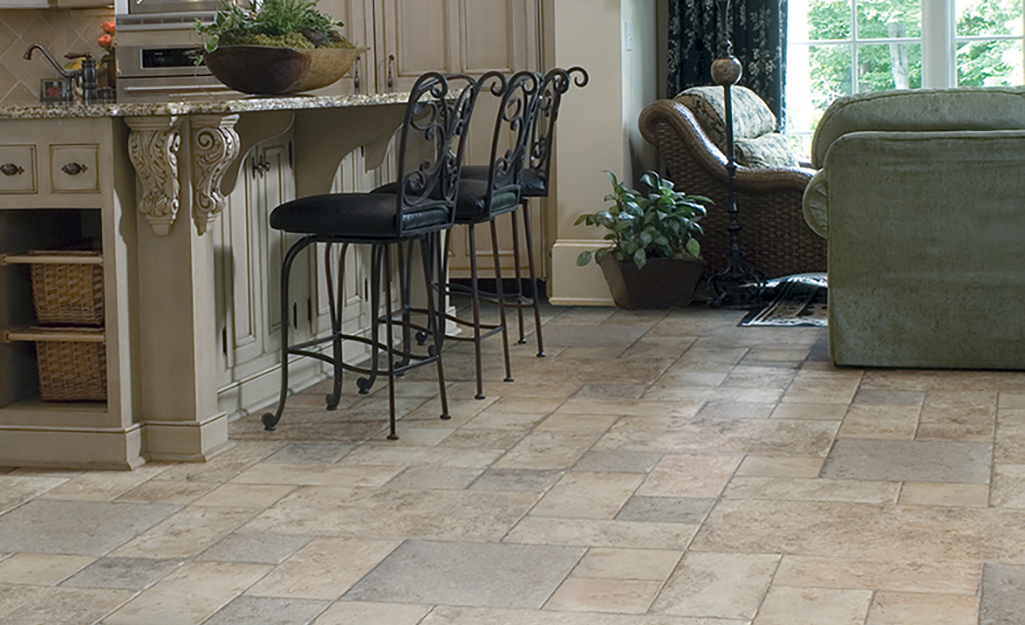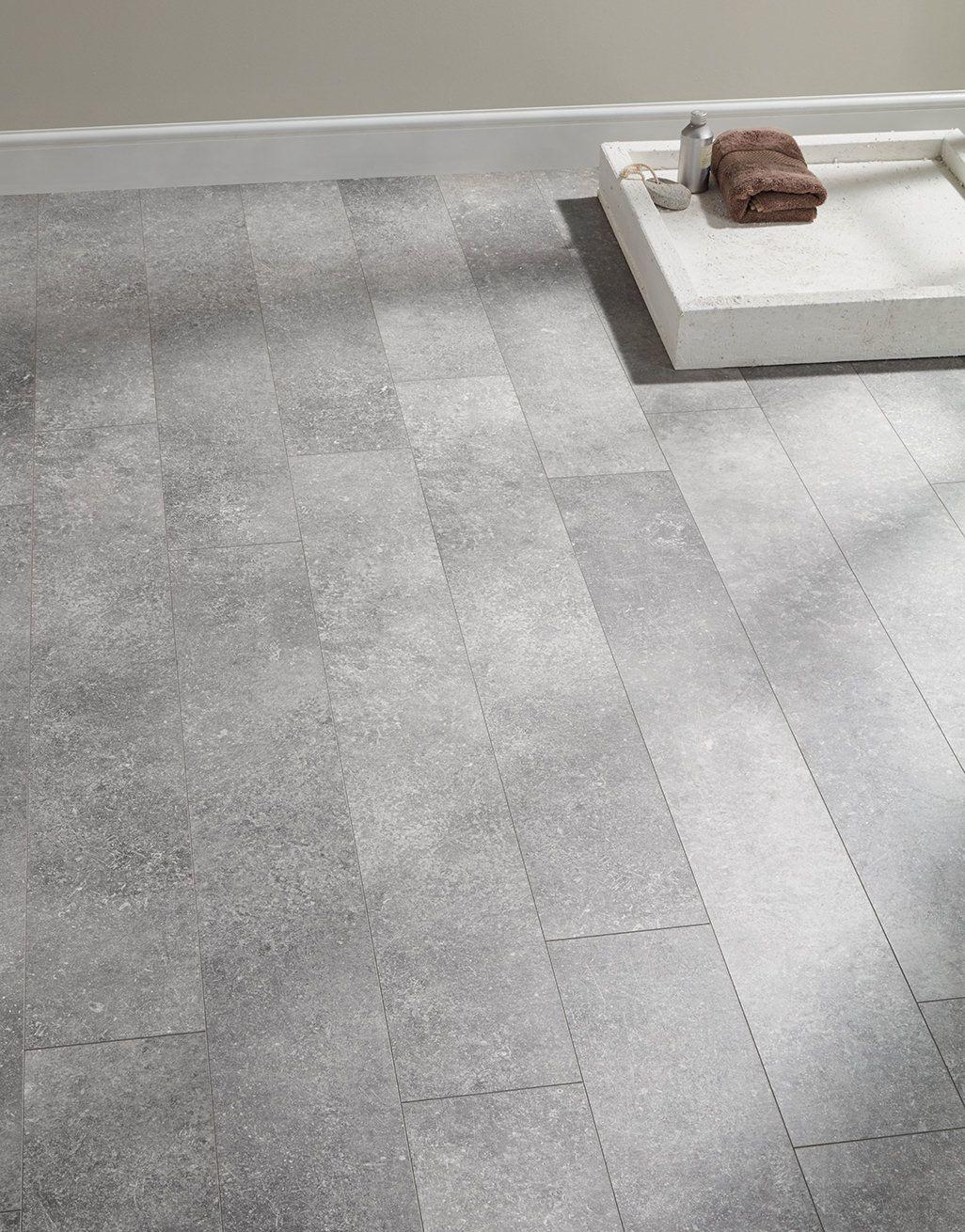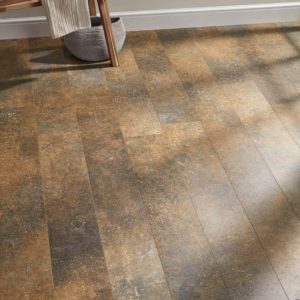The Benefits of Laminate Flooring in Kitchens
Laminate flooring has become a popular choice for kitchens due to its affordability, durability, and versatility. In particular, laminate flooring with a tile effect offers numerous benefits that make it an excellent option for kitchen spaces. We will see the advantages of using tile effect laminate flooring in kitchens, highlighting its unique features and why it’s worth considering for your kitchen renovation or upgrade.
- Authentic Look and Feel: One of the primary benefits of tile-effect laminate flooring is its ability to mimic the appearance and texture of real tiles. With advanced printing technology, laminate manufacturers can replicate various tile designs, including ceramic, porcelain, and stone. This allows homeowners to achieve the desired aesthetics of tile flooring without the high cost and maintenance associated with genuine tiles. Whether you prefer a sleek and modern look or a rustic and traditional feel, tile effect laminate flooring offers endless design possibilities.
- Durability and Resistance: Kitchens are high-traffic areas that require flooring that can withstand spills, stains, and heavy foot traffic. Tile effect laminate flooring excels in these aspects, as it is designed to be highly durable and resistant to scratches, impacts, and moisture. The protective top layer of laminate flooring ensures that it remains resistant to wear and tear, making it an ideal choice for busy kitchens where spills and accidents are bound to happen.
- Easy Installation and Maintenance: Compared to traditional tile flooring, tile effect laminate is relatively easy to install. It comes in convenient interlocking planks that can be installed without the need for adhesives or grout. This not only saves time but also minimizes the mess associated with tile installation. Additionally, laminate flooring is effortless to maintain. Regular sweeping and occasional mopping are usually sufficient to keep it clean. Unlike grout lines in real tile flooring, laminate does not require sealing, making it a more low-maintenance option for kitchens.
- Comfort and Sound Absorption: Unlike hard tile flooring, tile effect laminate offers a more comfortable underfoot feel. The inner core of laminate flooring provides a slight cushioning effect, making it easier on the joints, especially during prolonged periods of standing in the kitchen. Furthermore, laminate flooring has sound-absorbing properties, reducing noise levels in the kitchen. This can be particularly beneficial for households with open-concept kitchen and living areas, creating a more peaceful and enjoyable environment.
- Budget-Friendly Option: Tile effect laminate flooring is significantly more affordable than genuine tile flooring. This cost-effectiveness allows homeowners to allocate their budget towards other aspects of their kitchen renovation or upgrade. It provides an opportunity to achieve the desired aesthetics without compromising on quality or breaking the bank. With the wide range of tile designs available in laminate flooring, homeowners can find a budget-friendly option that suits their style and preferences.

Achieving a Stylish and Practical Kitchen with Tile Effect Laminate Flooring
When it comes to kitchen flooring, finding the perfect balance between style and practicality is essential. Tile effect laminate flooring offers a solution that combines the best of both worlds. Let’s see how tile effect laminate flooring can help you achieve a stylish and practical kitchen, discussing its design versatility, color options, and suitability for various kitchen styles.
Design Versatility: Tile effect laminate flooring comes in a wide range of designs and patterns that can complement any kitchen style. Whether you prefer a contemporary, rustic, or traditional look, there is a tile effect laminate that can match your vision. From sleek and minimalist tiles to intricate mosaic patterns, the design options are virtually limitless. This versatility allows homeowners to create a cohesive and visually appealing kitchen space that reflects their style and taste.
Color Options: In addition to its design versatility, tile effect laminate flooring also offers a plethora of color options. From classic shades of white and beige to bold and vibrant hues, there is a color that can seamlessly integrate into your kitchen’s color scheme. Whether you want to create a timeless and elegant atmosphere or add a pop of color to your kitchen, tile effect laminate flooring provides the flexibility to achieve your desired look.
Seamless Integration: Tile effect laminate flooring can be seamlessly integrated into various kitchen styles. For modern and contemporary kitchens, large-format tiles with clean lines and minimalistic patterns can create a sleek and sophisticated look. In contrast, homeowners looking to achieve a rustic or farmhouse-style kitchen can opt for laminate flooring with weathered stone or distressed wood finishes. The versatility of tile effect laminate allows it to adapt to different design themes, making it a practical choice for any kitchen style.
Enhanced Safety: In addition to its aesthetic appeal, tile effect laminate flooring also offers enhanced safety features. The textured surface of laminate flooring provides improved slip resistance, reducing the risk of accidents in the kitchen. This is especially important in areas prone to water spills, such as near the sink or stove. With tile effect laminate flooring, you can have peace of mind knowing that your kitchen is not only stylish but also safe for you and your family.
Practicality in Maintenance: Tile effect laminate flooring is designed to be practical and easy to maintain. Unlike real tiles with grout lines, laminate flooring has a smooth surface that is resistant to stains and dirt. Regular sweeping and occasional mopping are usually sufficient to keep it clean and looking its best. Additionally, unlike natural stone tiles, laminate flooring does not require periodic sealing or regrouting, saving both time and money in maintenance efforts.
Exploring the Durability and Resistance of Laminate Flooring in Kitchen Settings
Introduction: Durability and resistance are crucial factors to consider when choosing flooring for kitchen settings. Laminate flooring has proven to be a durable and resilient option, making it an excellent choice for kitchens. Below are the specific features of laminate flooring that contribute to its durability and resistance, highlighting its ability to withstand daily wear and tear, moisture, and impact.
Wear Layer: Laminate flooring is constructed with multiple layers, with the wear layer being the topmost layer that protects the floor from scratches, stains, and fading. The wear layer of laminate flooring is typically made of a high-density, transparent melamine resin that provides excellent durability. This layer acts as a shield, preventing damage from foot traffic, dropped utensils, and furniture movement commonly experienced in kitchen settings.
Scratch Resistance: Kitchens can be a high-traffic area prone to scratches caused by moving chairs, dropped knives, or pet claws. The wear layer of laminate flooring provides exceptional scratch resistance, ensuring that the flooring remains pristine and free from unsightly marks. This is especially important for maintaining the aesthetic appeal of the kitchen, as scratches can diminish the overall look of the flooring.
Moisture Resistance: Moisture is a common concern in kitchens, where spills and splashes are inevitable. Laminate flooring, when properly installed and maintained, exhibits good resistance to moisture. The core layer of laminate flooring is made of high-density fiberboard (HDF) or medium-density fiberboard (MDF), which are engineered wood products that are less susceptible to moisture damage compared to natural wood. Additionally, the wear layer and the water-resistant properties of laminate flooring prevent water from seeping into the core, reducing the risk of warping or swelling.
Impact Resistance: Kitchens are often bustling with activity, and accidental drops of heavy objects can occur. Laminate flooring is designed to be impact-resistant, thanks to its layered construction and the dense core material. The core layer provides stability and strength, while the wear layer absorbs impacts, preventing dents and damage to the flooring surface. This impact resistance ensures that your laminate flooring remains intact and retains its aesthetic appeal even in high-traffic kitchen areas.
Fade Resistance: Exposure to sunlight can cause some flooring materials to fade over time, resulting in an uneven appearance. However, laminate flooring is manufactured with UV protection in the wear layer, making it highly resistant to fading. This means that your tile effect laminate flooring will retain its vibrant colors and patterns even when exposed to direct sunlight in the kitchen. With fade-resistant laminate flooring, you can enjoy a beautiful and long-lasting kitchen flooring solution.
Easy Maintenance and Cleaning Tips
Tile effect laminate flooring offers the perfect blend of style and practicality for kitchens. Not only is it durable and resistant, but it is also easy to maintain. Below we provide you with some handy maintenance and cleaning tips to ensure that your tile effect laminate flooring remains in top condition, allowing you to enjoy a beautiful and hassle-free kitchen.
Regular Sweeping: Regular sweeping is essential to remove loose dirt, dust, and debris from the surface of your tile effect laminate flooring. Use a soft-bristle broom or a microfiber dust mop to gently sweep the floor, ensuring that no abrasive particles scratch the laminate surface. Sweeping should be done at least once a week, or more frequently in high-traffic areas or if you have pets.
Prompt Spill Cleanup: Accidental spills are bound to happen in the kitchen. To prevent any potential damage to your laminate flooring, it is crucial to clean up spills promptly. Use a soft, slightly damp cloth or sponge to wipe away the spill, ensuring that no moisture seeps into the laminate joints. Avoid using excessive water, as prolonged exposure to moisture can cause the laminate to swell or warp. For stubborn stains, use a mild cleaner recommended by the laminate manufacturer.
Avoid Harsh Chemicals: When cleaning your tile effect laminate flooring, it is important to avoid using harsh chemicals, abrasive cleaners, or wax-based products. These can damage the protective wear layer of the laminate and compromise its durability. Instead, opt for mild, pH-neutral cleaners specifically formulated for laminate flooring. Dilute the cleaner according to the manufacturer’s instructions and use a damp mop or cloth to clean the floor. Always dry the floor thoroughly after cleaning.
Protect Against Scratches: Although tile effect laminate flooring is scratch-resistant, it is still advisable to take preventive measures to protect its surface. Place felt pads or furniture glides underneath the legs of furniture to prevent scratches when moving or rearranging items. Avoid dragging heavy objects across the floor and use rugs or mats in high-traffic areas or under chairs to provide an extra layer of protection. Regularly trim your pet’s nails to minimize the risk of scratches.
Preventing Excessive Moisture: While laminate flooring is moisture-resistant, excessive moisture can still cause damage over time. Avoid using excessive water when cleaning and immediately wipe up any spills to prevent moisture from seeping into the laminate joints. Place mats or rugs near sinks, dishwashers, and other areas prone to water splashes to absorb excess moisture. Additionally, consider using a dehumidifier in humid climates or during periods of high humidity to maintain optimal conditions for your laminate flooring.
Protecting Against Heat: Tile effect laminate flooring is resistant to heat, but it is still important to take precautions to prevent heat-related damage. Place trivets or hot pads underneath hot pots, pans, and appliances to protect the laminate surface from direct heat. Avoid placing hot items directly onto the laminate flooring to prevent discoloration or warping.
Regular Maintenance: In addition to regular sweeping and prompt spill cleanup, it is recommended to perform regular maintenance tasks to keep your tile effect laminate flooring looking its best. Periodically damp mop the floor using a well-wrung mop and a mild laminate cleaner. Avoid using excessive water and ensure the floor is thoroughly dried after cleaning. Avoid using steam mops or excessive moisture, as this can damage the laminate.
Protective Mats and Rugs: To further protect your tile effect laminate flooring, consider placing protective mats or rugs in high-traffic areas, near entryways, and under kitchen sinks. These mats can help trap dirt and debris, preventing them from scratching the laminate surface. Choose mats or rugs with non-slip backing to ensure they stay in place and avoid using rubber or latex-backed mats, as these can cause discoloration on the laminate flooring.
Professional Maintenance: If your tile effect laminate flooring requires deeper cleaning or maintenance, consider consulting a professional. They can provide specialized cleaning and maintenance services to ensure your laminate flooring remains in optimal condition. Professional maintenance can include deep cleaning, buffing, or refinishing, depending on the specific needs of your laminate flooring.
Choosing the Perfect Tile Effect Laminate Flooring
Introduction: Choosing the right tile-effect laminate flooring for your kitchen can greatly enhance its aesthetic appeal. With a wide variety of options available, it’s important to consider factors such as design, color, texture, and pattern to ensure that your flooring complements your kitchen’s overall style. We will guide you through the process of selecting the perfect tile effect laminate flooring for your kitchen’s aesthetic.
Consider the Kitchen Style: Start by considering the style and theme of your kitchen. Is it modern and sleek, rustic and cozy, or traditional and timeless? The style of your kitchen will play a significant role in determining the type of tile-effect laminate flooring that will best suit the space. For a modern kitchen, opt for laminate flooring with clean lines and minimalist patterns. Rustic kitchens can benefit from laminate flooring that mimics the look of weathered stone or distressed wood. Traditional kitchens often pair well with laminate flooring that resembles classic ceramic tiles.
Design and Pattern: Tile effect laminate flooring comes in a wide range of designs and patterns, allowing you to choose the one that best fits your kitchen’s aesthetic. Consider the size of the tiles you prefer, as larger tiles can create a sense of spaciousness, while smaller tiles can add visual interest and texture. Some laminate flooring designs feature intricate patterns, such as mosaic or herringbone, which can be used as a focal point or to create a unique look in your kitchen.
Color Selection: The color of your tile effect laminate flooring should complement the overall color scheme of your kitchen. If you have a neutral color palette, consider laminate flooring in shades of white, beige, or gray, as these can create a clean and timeless look. For a more vibrant and bold kitchen, opt for laminate flooring in rich colors like deep blues or greens. Remember to consider the lighting in your kitchen, as natural light can affect the appearance of laminate flooring colors.
Texture and Finish: The texture and finish of your tile effect laminate flooring can contribute to the overall feel of your kitchen. Smooth and glossy finishes can create a sleek and modern look, while textured finishes can add depth and character to your flooring. Consider the texture of the laminate flooring with other elements in your kitchen, such as the countertops and cabinetry, to ensure a cohesive and harmonious design.
Samples and Visualizing: To truly get a sense of how different tile effect laminate flooring options will look in your kitchen, it’s recommended to request samples from manufacturers or visit a local flooring showroom. Take these samples home and place them in your kitchen under different lighting conditions to see how they interact with your existing décor. This will help you visualize how the laminate flooring will look in your space and make a more informed decision.
Consider Lifestyle and Maintenance: When choosing tile effect laminate flooring for your kitchen, it’s important to consider your lifestyle and maintenance preferences. If you have a busy household with children or pets, opt for laminate flooring with a durable wear layer that can withstand heavy foot traffic and resist scratches. Additionally, consider the ease of maintenance. Some laminate flooring options are designed to be more stain-resistant and easier to clean than others, making them more suitable for kitchens where spills and messes are common.
Budget Considerations: Last, consider your budget when selecting tile effect laminate flooring for your kitchen. Laminate flooring is generally more affordable than other flooring options, but prices can vary depending on the brand, quality, and design. Set a budget and explore laminate flooring options within that range. Remember, it’s possible to find high-quality and aesthetically pleasing laminate flooring that fits your budget.
Baelea Ceramic Aqua Industrial Light Grey Laminate Flooring
Bathroom Laminate Flooring Discount Flooring Depot
Retro 8mm Traditional Waterproof Tile Laminate Flooring (S172616)
100% Waterproof Laminate Flooring for Kitchens u0026 Bathrooms
Related Posts:
- White Laminate Flooring In Living Room
- Grey Vintage Oak Laminate Flooring
- Dark Laminate Flooring Living Room
- Cheap Walnut Laminate Flooring
- Designer Choice Laminate Flooring
- Laminate Flooring Around Stairs
- Laminate Flooring Brick Pattern
- Black Gray Laminate Flooring
- Satin Walnut Laminate Flooring
- Laminate Floor Leveling







